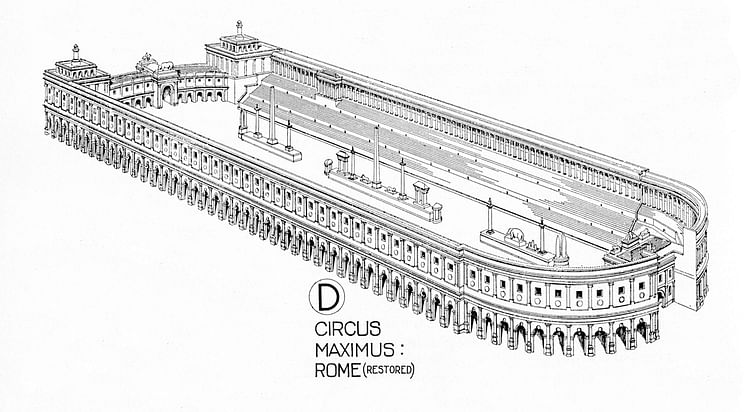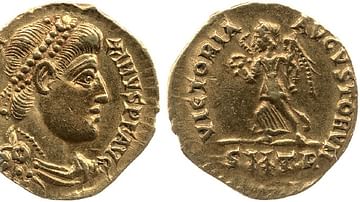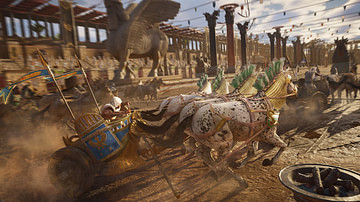Museums have been around much longer than one might think, but in the ancient world, they were principally institutions of research and learning rather than places to display artworks and artefacts, even if they were often located in grand buildings and decorated with examples of fine sculpture and painting. The name 'museum' derives from the Muses, those nine Greek goddesses associated with wisdom and the arts. The most celebrated example in the ancient world was the Museum of Alexandria, a part of which was the now much more famous Library of Alexandria. In terms of art for the public's enjoyment, there were alternative places such as the collections within royal palaces, temples, baths and libraries, and, for monumental art, such public arenas as circuses and amphitheatres. In short, then, a citizen of the ancient Mediterranean did not usually lack places where they could admire fine artworks which told tales from mythology and religion, represented episodes of literature and warfare, or gave an exotic glimpse of conquered lands and faraway places.

Origins
The name museum derives from the nine Muses of Greek mythology, each of which was credited with a particular skill in the arts. A natural spot where birds sang, for example, was a typical place given attachment to the Muses. Such sacred places might then receive an altar or small temple as it was believed the Muses were present there. These places were the very first 'museums'. We know that Mount Helicon in southwest Boeotia - the spot where the Greek writer Hesiod (c. 700 BCE) claimed to have met the Muses - had a museum which contained works of Hesiod and statues of figures associated with the arts. Schools, in particular, came to be referred to as 'the places of the Muses'.
The great schools of such famed philosophers as Plato (c. 428 - c. 347 BCE) and Aristotle (384-322 BCE), the Academy and Lyceum, respectively, both in Athens, each had a museum. The Lyceum (aka Peripatos) especially, was a model followed by later institutions. Founded around 335 BCE, the Lyceum had three distinctive features: the teamwork of its scholars, its encyclopedic research, and the ambitious goal of assembling as many complete documentary sources as possible.
Books, Baths & Schools
In antiquity, there was often no particular distinction between libraries and museums, and both could occupy the same building. The ancient library - from Athens to Alexandria - was often a place where legal, sacred and administrative documents were stored, a rich repository of literary works, and a place where lectures could be heard. Early libraries were often attached to a temple or royal palace. Greek libraries also came to be attached to public gymnasiums and eventually private libraries developed, too. The first Greek public library is credited by ancient authors to the efforts of Peisistratos of Athens (d. c. 527 BCE). Libraries became the homes of philosophical schools and educational institutions. Documents were typically in the form of wax or clay tablets, papyrus or leather scrolls, and parchment codexes. The idea was that visitors - usually scholars - could go and read these documents (but could not remove them from the building), much as we would use a reference library today. The texts were kept in partitioned wooden cupboards and these were set in niches in the walls. Other niches often contained statues and so learning and art came to be associated together.

Just as wealthy citizens donated scrolls to libraries, so too, artworks were given to beautify what was already one of the most pleasant environments in any large city. Libraries were built using fine marble, had striking mosaic floors, and often a colonnaded garden complete with stone seating and water features. One well-documented example was the Library of Hadrian in Athens (built c. 132-134 CE). This library, the largest in the city, was famously described by Pausanias as "the building with 100 columns of Phrygian marble, with halls with painted ceilings, alabaster walls, and niches with statues, in which books were kept" (Attica). One sign that survives from another library in Athens, that of Pantaenus, states: 'No book shall be taken out…Open from dawn to midday' (Hornblower, 830).
The Romans spread the idea of public libraries, often attached to Roman baths, all across their empire. The concept that books belonged to everybody was now firmly established. Indeed, Roman Baths were another kind of museum in themselves, this time one open to the public. Baths were not only splendid buildings with soaring domes and arches, ornate fountains and flashy mosaic walls and ceilings, but they were frequently adorned with statues and artworks. Statues represented not just the gods but also politicians, orators, philosophers, and poets.
Palaces
Royal palaces, too, became museums in the modern sense as rulers collected fine art from the territories they conquered. Even in the Bronze Age, the Minoans of Crete were collecting fine pieces from across the Aegean. The general public could not see them, of course, but rulers seem to have always delighted in showing off their connoisseurship to their favoured inner circle of friends and to visiting ambassadors. Indeed, ambassadors from other kingdoms were an important source of collections as the giving of precious gifts were a common part of international relations.

The Palace of Constantinople, first built in the 4th century CE, is perhaps the most famous example from antiquity. The palace acquired all manner of works thanks to the endeavours of one Lausus, a powerful court eunuch. Collection highlights included the Statue of Zeus at Olympia (one of the Seven Wonders of the World and moved there in 395 CE), the Cnidian Aphrodite by the famed Greek sculptor Praxiteles, an emerald statue of Athena, and a famous statue of Hera from Samos. None of these works has survived. When Christianity took over as the main religion, many sacred objects also found their way to the Palace. These included the Mandylion icon, a shroud thought to have been imprinted with an impression of the face of Jesus Christ in the now-classic pose known as the Pantokrator which is seen today in churches worldwide. The shroud was taken to France by Crusader knights but then lost during the French Revolution. The Palace's main gate, the Chalke Gate, displayed the biggest icon in Constantinople, a gilded representation of Jesus Christ known as Christ Chalkites.
Within the Palace was the Chrysotriklinos, the main audience hall built by Justin II (r. 565-574 CE). The room was awash with gold decorations, hence its name, which means "Golden Hall". To make sure visitors were left in no doubt as to the Byzantine emperor's power and wealth there was a huge cabinet, the pentapyrgion, which was filled with treasures from across the Byzantine Empire.
Temples & Sacred Sites
Richly decorated temples such as the Parthenon, which usually had a wondrous statue of a god inside made of wood, gold, and ivory, and sacred sanctuary sites like Delos offered another form of what we would today consider a museum or gallery. Sites like Delphi and Olympia received donations from city-states across the Mediterranean, and these were not in the form of cash but dedicatory statues, small ornate buildings, tripods, weapons, helmets, shields and armour in the hope that the gods would favour the donator.
A tour around these open-air sites and their treasury buildings would have struck wonder in the beholder and given the visitor an insight into the development of art and military technology over centuries. Some of the artworks gained fame in their own right. At Delphi, for example, there was the great bronze Bull of Corcyra (580 BCE), the ten statues of the kings of Argos (c. 369 BCE), a giant gold four-horse chariot offered by Rhodes, and a huge bronze statue of the Trojan Horse offered by the Argives (c. 413 BCE). Lining the sacred way at Delphi which pilgrims followed were hundreds of statues, of which only the pedestals now survive. Olympia had a similar array of statues, this time of victorious athletes in the Olympic Games.
Circuses
Another museum of sorts, another open-air one, was the Circus Maximus of Rome. First built in the 6th century BCE, the Circus was used to host chariot races, gladiator fights, wild animal hunts, public executions, and games, including the annual Ludi Romani which honoured Jupiter. The Circus had a capacity for 250,000 spectators, and they could admire from their seats not only these spectacles but also the collection of massive monuments and artworks which adorned the central barrier, or spina, around which the chariots raced. Here there were obelisks from Egypt alongside bronze and marble statues of the rich and famous. Two of the obelisks now stand in Rome, one in the Piazza del Popolo and the other in the Piazza S. Giovanni in Laterano.
The spina of the Hippodrome of Constantinople (3rd - 13th century CE) had an even more spectacular array of artworks, all looted from across the Byzantine Empire. There were monumental sculptures of early Roman emperors, figures associated with victory such as eagles and the Greek hero Hercules, sculptures of victorious charioteers, and ornamental columns such as the Serpent Column of the Plataian tripod. This latter wonder of three entwined snakes in bronze was a 5th-century BCE dedication looted from the sacred sanctuary of Apollo at Delphi. Once standing 8 metres (26 ft.) tall, the lower portion is still standing today in Istanbul. There were obelisks, too, including a false one made of individual blocks but entirely covered in bronze sheeting. Another Egyptian obelisk had been removed from Karnak and dates to the reign of Thutmose III in the 15th century BCE. The monument, measuring over 25 metres (82 ft.) in height, now stands in central Istanbul.
Besides the spina, the exterior of the Hippodrome, like many public buildings in the Roman world, was decorated with the spoils of war such as weapons, armour, and shields, no doubt hung there to remind the general populace of all the peoples the Eastern Roman Empire had conquered.
The Museum of Alexandria
The most famous museum in the world was in Alexandria. It was quite distinct from the Library of Alexandria. Ptolemy I Soter (366-282 BCE) is considered the founder of the Museum of Alexandria (the Mouseion) c. 305 BCE, of which the famed library was only a part. The Ptolemaic Dynasty spent a great deal of time and money building up both the Museum and Library of Alexandria, inviting scholars and acquiring texts from all over the Mediterranean. Most ancient sources credit Ptolemy II Philadelphos (r. 285-246 BCE) with the library's foundation. The librarians, operating under a director, were ruthless and absolutely determined to build the world's greatest store of knowledge by leaving no source and no subject uncovered. As a result of these endeavours, the library boasted 500,000-700,000 scrolls.
The model for the conception of the Museum was likely Aristotle's Lyceum mentioned above, a strong connection being the presence of Demetrios of Phaleron (c. 350 - c. 280 BCE), a student of Aristotle. The precise location of the Museum is not known but it was most likely near the royal palace. The Museum was managed by a president or head priest who had a team of live-in scholars paid by the state (both a salary and living expenses). Research, copying books, and giving lectures were their primary pursuits. The first of these tasks gained the Museum its widest fame, particularly in the areas of science, mechanics, medicine, mathematics, philosophy, and literary scholarship.
The Greek geographer Strabo (c. 64 BCE - c. 24 CE) gives the following description of the Museum:
It has a cloister and an arcade and a large house in which is provided the common meal of the men of learning who take part in the Museum. And this gathering has common funds, and a priest in charge of the Museum, who was appointed previously by the kings, but now by Caesar.
(Bagnall, 4633)
The Museum also hosted dinners and the occasional symposium (from the informal drinking party the Classical Greeks had created) where discussions were held on all manner of topics from politics to ethics. Rather more serious than elsewhere, the solutions to problems discussed at the Museum of Alexandria's symposia were recorded for posterity. The discussion sessions were frequently attended by rulers, including Cleopatra VII (r. 51-30 BCE). The Museum also managed the Library's distribution of books to other towns in the Ptolemaic Empire. The Museum and the Library were both damaged by fire during the reign of Julius Caesar (b. c. 100 BCE) but then continued and were even expanded by such Roman emperors as Hadrian in the 2nd century CE. The Museum also inspired other similar institutions elsewhere, notably at Pergamon, Rhodes, and Syracuse. Destroyed in 272 CE, the Museum of Alexandria once again recovered but went into decline and the last known member of the Museum is recorded as Theon of Alexandria, the mathematical commentator and father of the famed philosopher and mathematician Hypatia (c. 370 - 415 CE). Following the edict of Theodosius I (r. 379-395 CE) to close all pagan sites in 391 CE, the Museum disappeared from history but it created a model on which many museums, such as the British Museum and Louvre, today follow, not only presenting artworks and artefacts but also funding research and educational initiatives.







